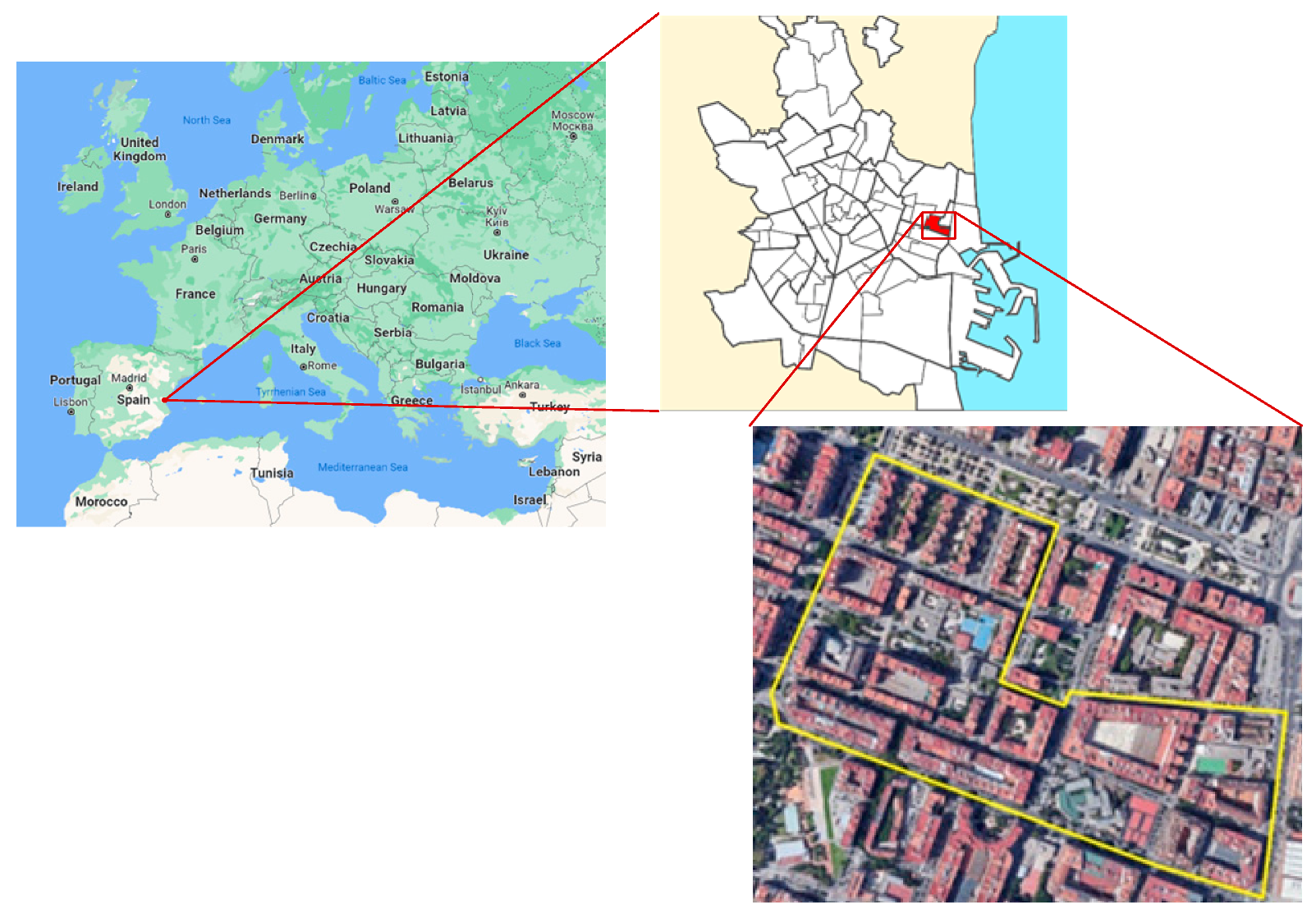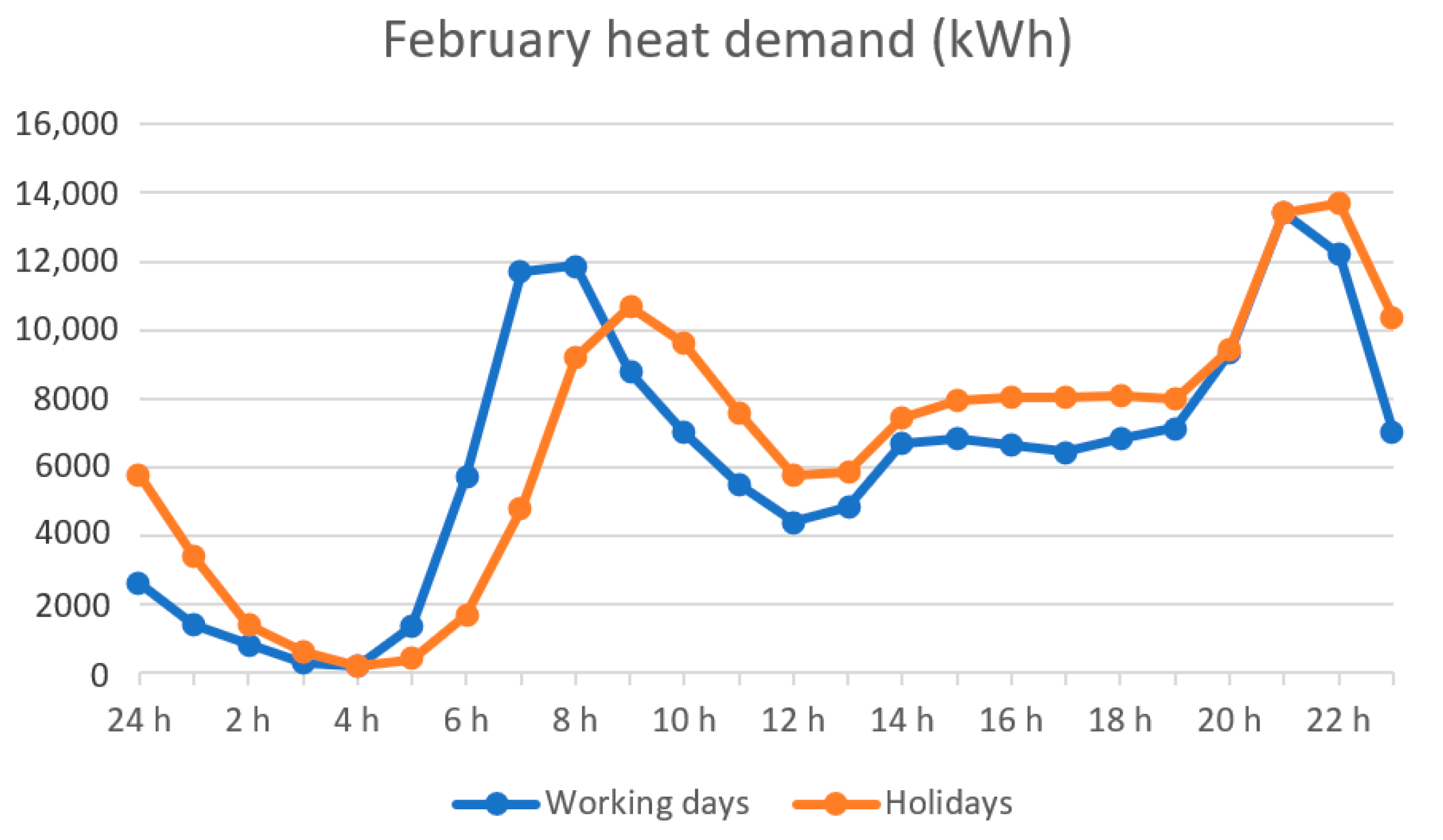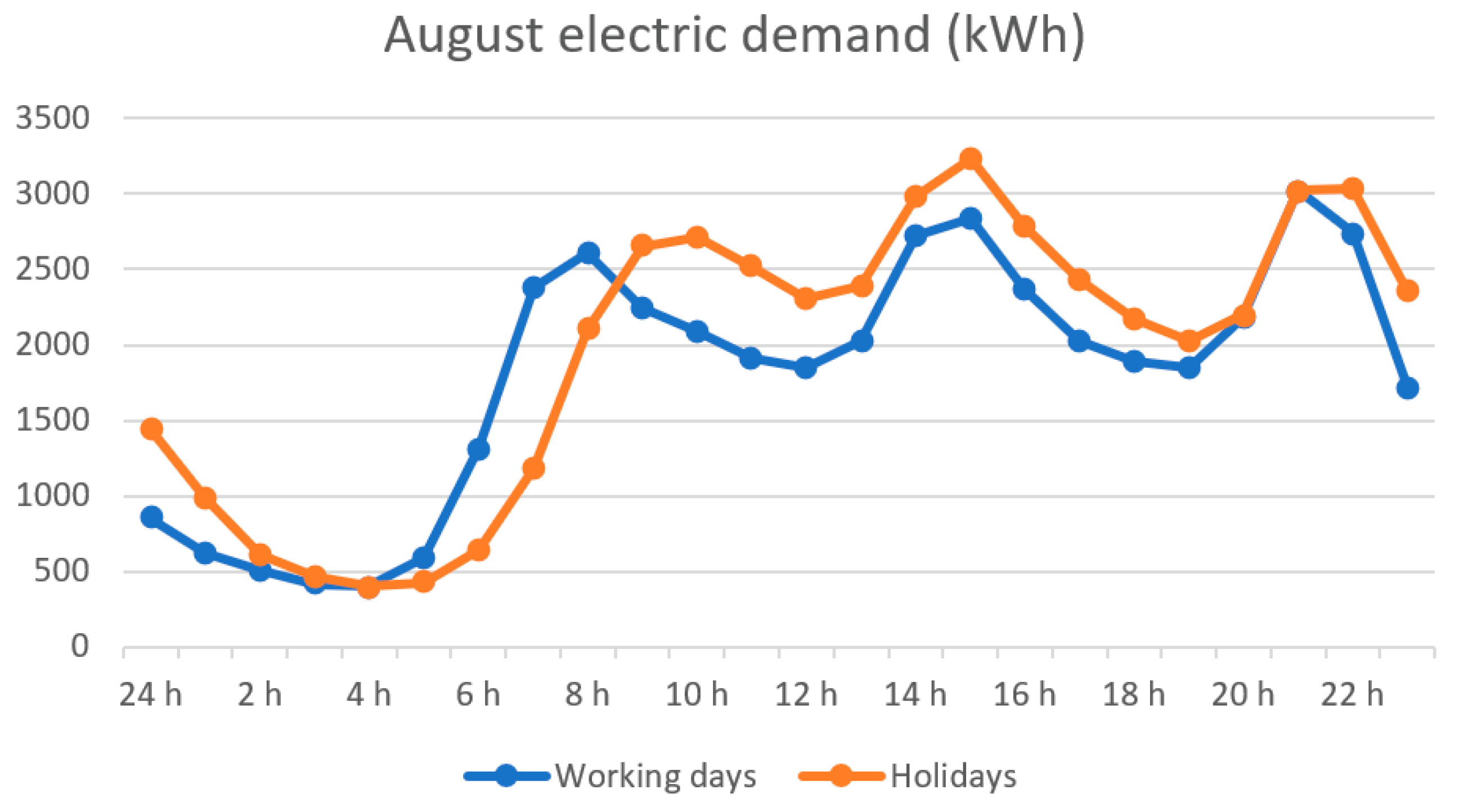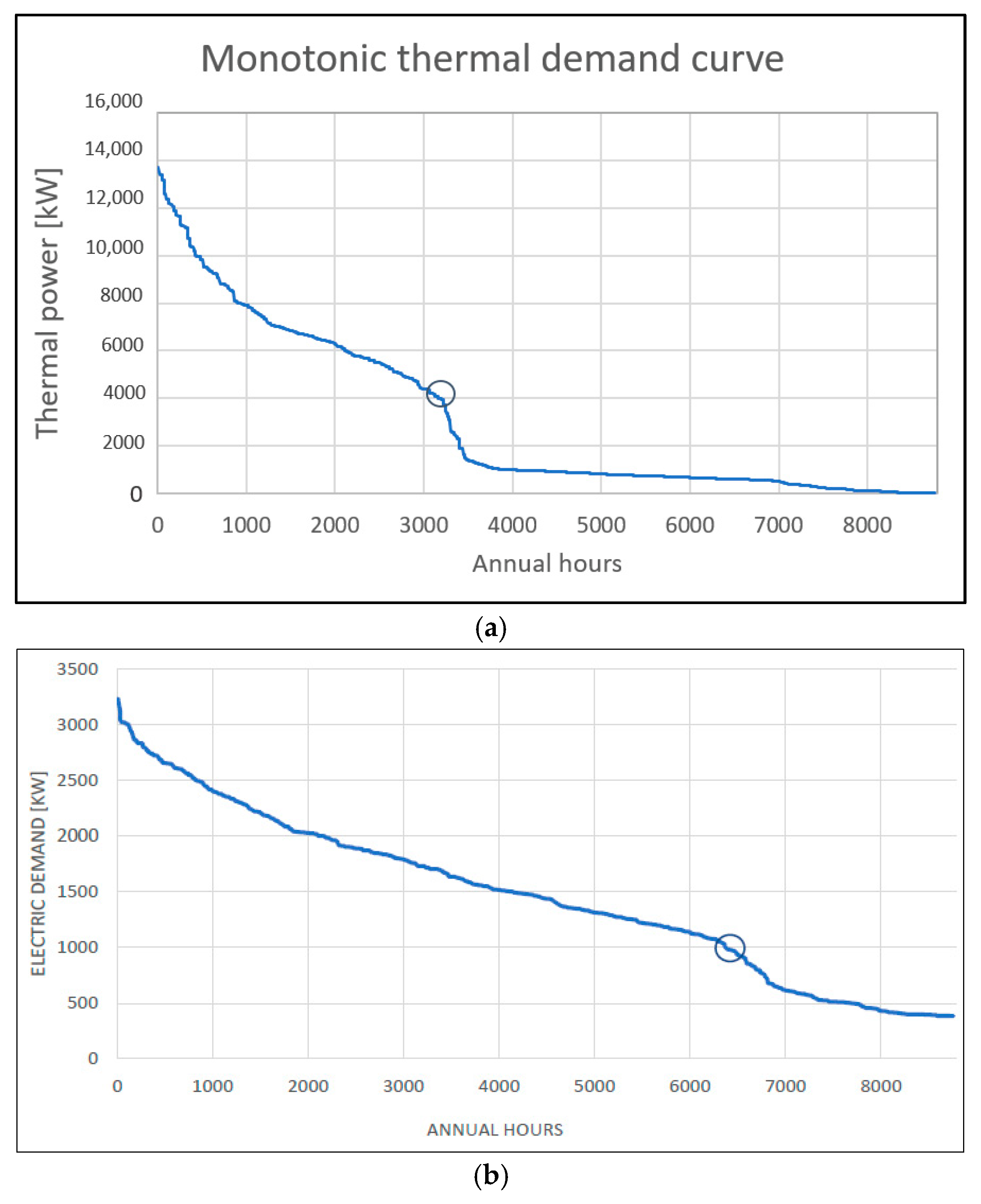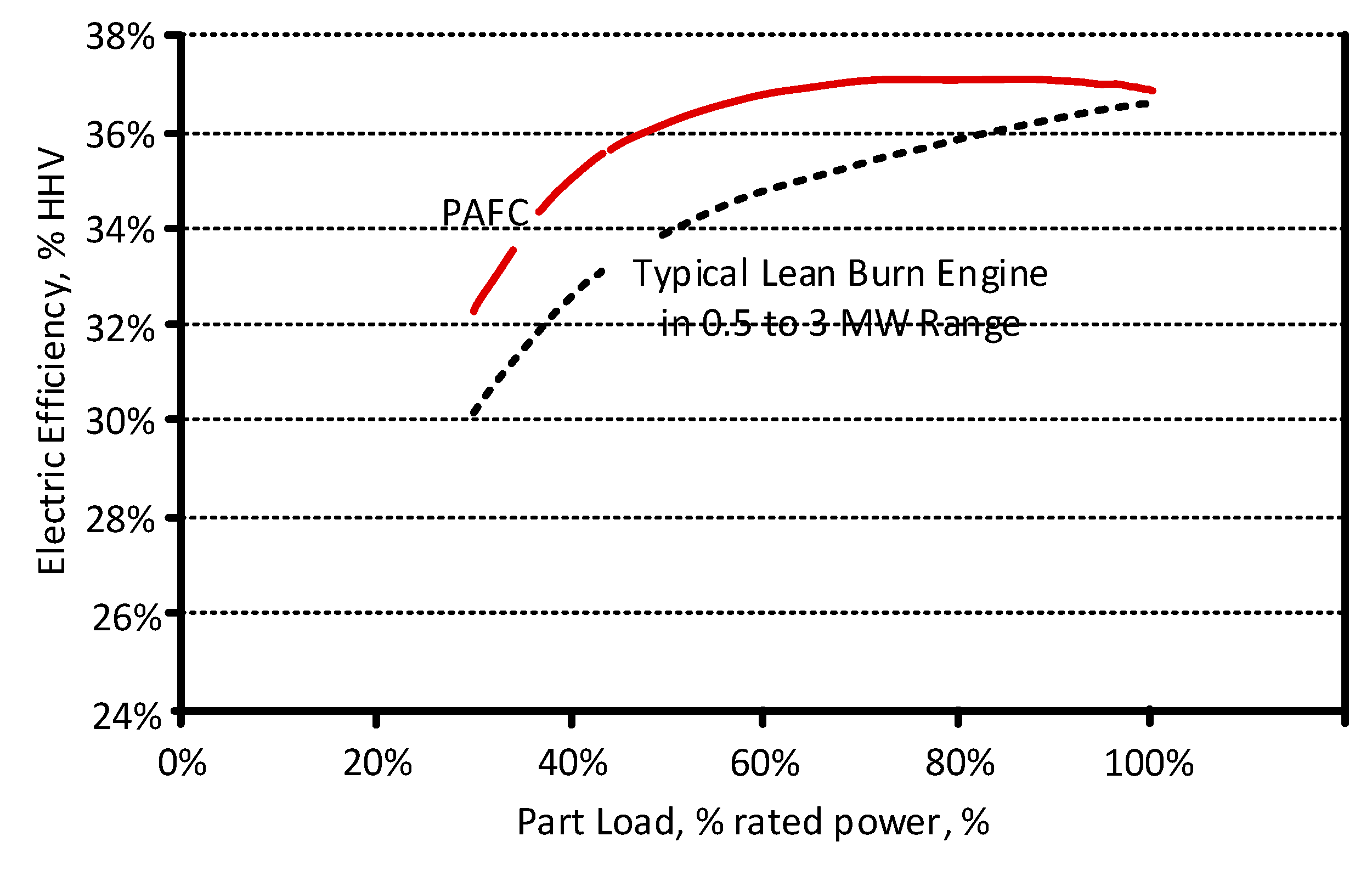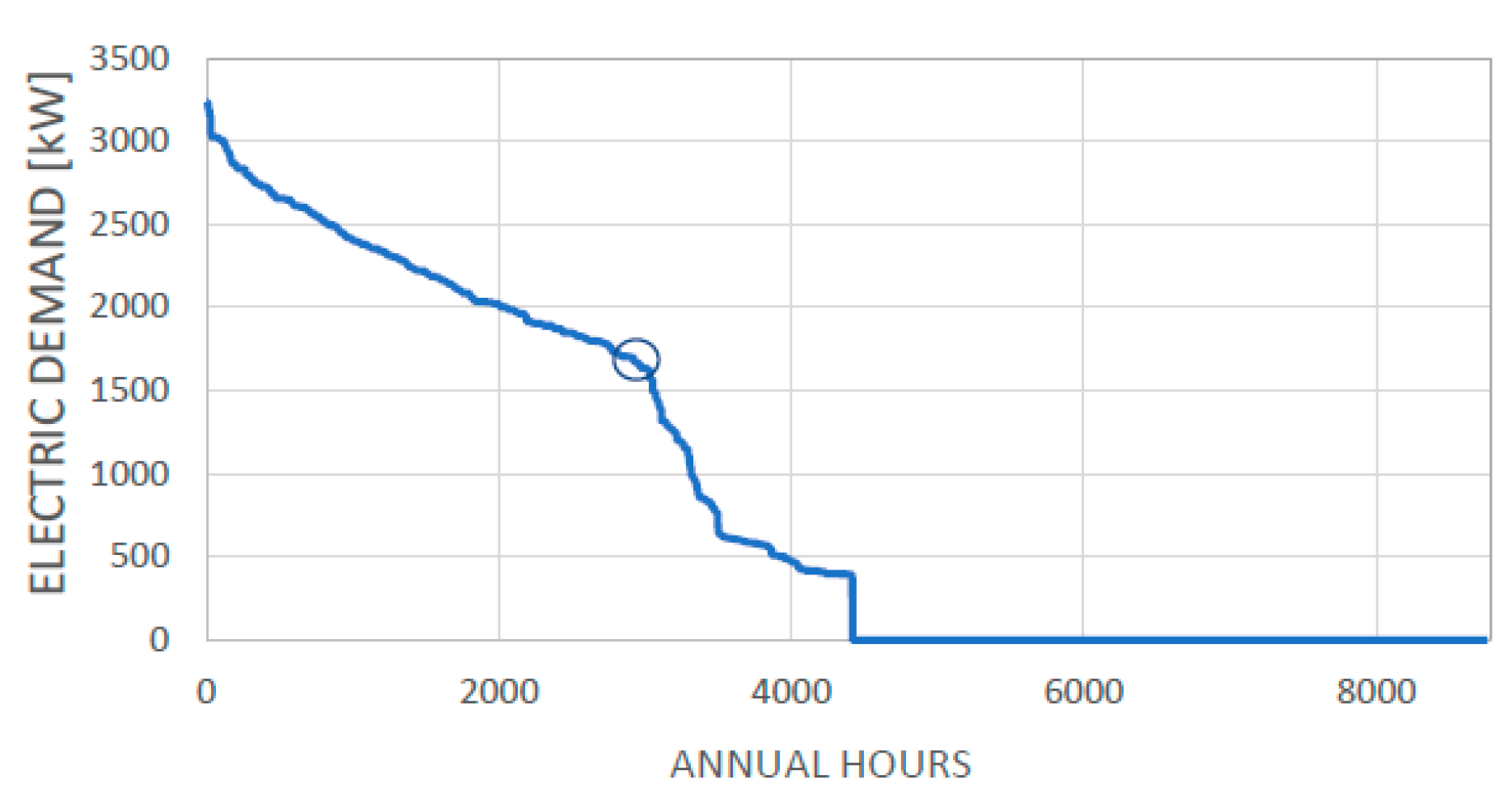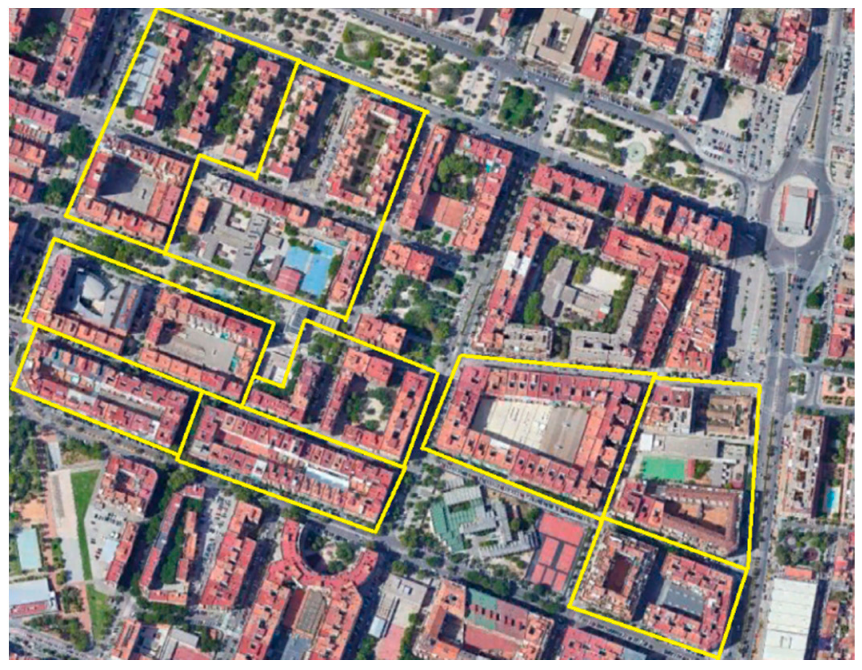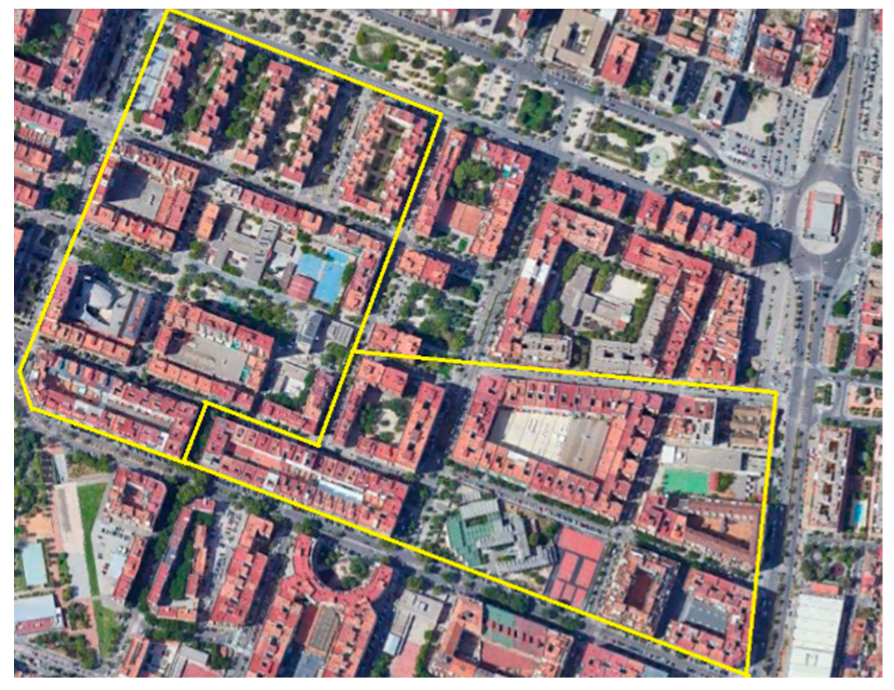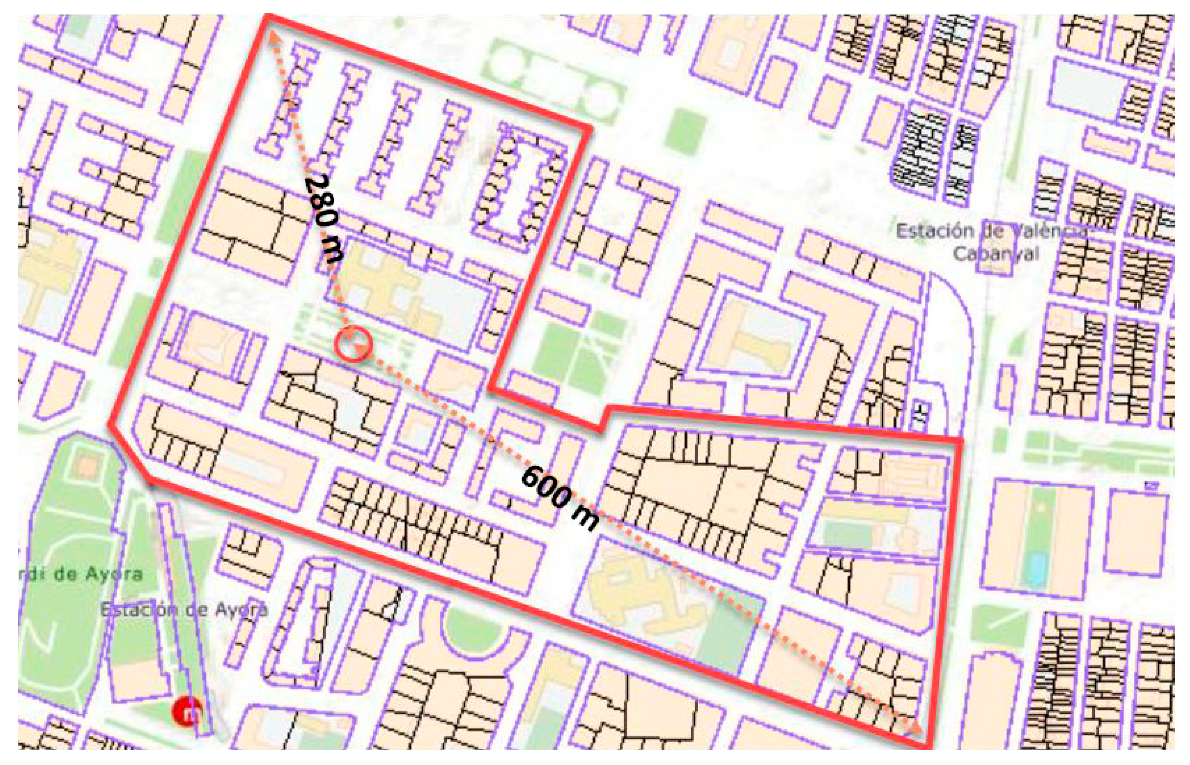The following parameters were calculated for each of the alternatives presented in the previous section:
5.1. Results Obtained and Comparison of the Alternatives Developed for a 4 MW Thermal Power Production System
For ease of comparison,
Table 9 summarises the most important parameters for each of the alternatives developed.
Despite the high annual savings achieved with the CHP system, the investment is very high, hence unfavourable payback periods occur in all the cases. However, the implementation would be considered feasible as the lifetime of the fuel cells is on average 25 years, so that the investment would be recovered and there would be gains in the later years.
In order to make a comparison between centralised and distributed generation, one must compare e alternatives in which fuel cells are programmed to follow the same energy demands during the year. Therefore, if we compare the first alternative with the third alternative, both with the system prepared to follow the thermal demand but the first one being a centralised system and the third one a distributed generation system, we can conclude that the first one presents better results both energetically and economically. This is due to the fact that there are large differences in thermal demand during the year due to the high demand for heating caused by poor building envelopes, so that following the thermal demand in a distributed installation would force the system to work at low partial loads in the months when this demand is not so high, which coincides with the months when heating is not needed, so that much efficiency is lost and it is more profitable both economically and energetically to operate with the conventional system during this time of year, which means that the advantages of a cogeneration system are not taken advantage of.
On the other hand, comparing the second and fourth alternatives, which follow thermal demand when there is a heating demand and the electrical demand when there is a cooling demand, the second being a centralised system and the fourth a distributed generation system, there is not as much difference as in the previous comparison. The difference lies in the fact that in distributed generation, all the batteries are kept in operation throughout the year, which means that greater electricity coverage is achieved and a higher percentage of self-consumption in the hot months, which are those with the highest electricity demand, although at the same time, energy savings are not achieved because consumption is not compensated by production. Even with distributed generation, less electricity needs to be imported from the grid, and this is compensated by higher fuel costs and lower income from the sale of surpluses. It can be concluded that for a CHP system of 4 MW of thermal power, better results are achieved with a centralised system.
To compare the mode of operation in which the fuel cells work, the first alternative is compared with the second alternative. The biggest advantage of the first alternative is primary energy savings, since, by not producing more heat than demanded, all the thermal energy generated by the fuel cells is useful. Despite this parameter, the rest of the energy and economic results are better for a system that follows the electricity demand during half of the year. On the other hand, comparing the distributed generation cases, practically the same conclusions can be drawn as with the previous comparison. The primary energy savings are higher in the case of the continuous mode of operation in which the thermal demand is followed, because the consumption is compared with the production and no heat energy is wasted. In all other parameters, better results are also achieved with the system that follows one or the other demand depending on the season. By tracking electricity demand in the months with cooling demand, the batteries can operate at partial loads above 50% and do not need to be shut down, thus increasing both the economic and energy benefits of the CHP installation.
Therefore, it can be assumed that the best option for a CHP system of 4 MW thermal power is a centralised system. The choice between the first and the second alternative is more complex, since, as explained above, the second alternative presents better results except for primary energy savings. Given that better coverage of demand and greater economic savings are achieved with the second alternative, it was decided to opt for this configuration in the case of choosing a system with 4 MW of thermal power. Thus, a study of alternatives for a cogeneration system with 1 MW of electrical power was carried out.
5.2. Results Obtained and Comparison of the Alternatives Developed for a Production System of 1 MW of Electrical Power
The changes from one alternative to the other were not as significant as the previously analyzed CHP system which had more power (4 MW), but the parameters were compared, as in
Table 10, to determine which alternative is better for the case of this 1 MW CHP system.
In order to make a comparison between centralised generation and distributed generation, the alternatives with fuel cells programmed to follow the same energy demands during the year must be compared. The energy results obtained are very similar in terms of demand coverage achieved and primary energy savings. In terms of economic results, distributed generation offers higher annual economic savings. This is because better regulation of the fuel cells allows greater adaptability to demand, and less electricity needs to be imported, which is currently the most expensive energy.
As for the difference between the mode of operation to be followed for fuel cells, the fifth alternative is compared with the sixth alternative, and the seventh alternative with the eighth alternative. Both the thermal coverage and the electrical coverage are slightly lower in the operation mode that follows the year-round electrical demand as well as the primary energy savings. This is caused by the increase in evacuated heat that occurs when following the electrical demand. On the other hand, the economic results are also better for systems that follow both energy demands, as surplus energy is produced which generates remuneration at market price.
Therefore, although there is not a big difference between the alternatives studied, it is concluded that the best configuration for this CHP system would be the one corresponding to the eighth alternative. i.e., a distributed generation system that follows the thermal demand when heating is required and the electrical demand when there is a cooling demand.
5.3. Selection of the Most Appropriate Alternative
Since the different configurations and modes of operation of the two cogeneration systems were compared in the previous section and a decision made as to which is better in each case, the final choice of the alternative depends on the cogeneration system to be chosen.
As initially intuited, a system that prioritises covering thermal demand offers greater coverage of thermal demand and electricity demand. On the other hand, although the annual savings are also much higher, it requires a much larger initial investment and therefore presents a less viable economic result than a CHP system that prioritises covering the electricity demand.
The cogeneration system of 4 MW of thermal energy was further developed. Despite the lower profitability, the energy results obtained were satisfactory and a large annual economic saving was achieved, which, over the years would amortize investment and could lead to significant profits. Furthermore, given that the aim of this study was to test the viability of stationary fuel cells in compact Mediterranean cities, by choosing a higher power fuel cell it is easier to appreciate the characteristics offered, although it is not an economically viable system.
The energy and economic results obtained for this cogeneration system are shown below (
Table 11,
Table 12,
Table 13 and
Table 14), compared to the current system based on complete dependence on the electricity grid for electricity supply and conventional gas-fired boilers to meet thermal needs.
As nine fuel cells are needed in total and centrally, the system can become very complex. This largely depends on the location of the stacks, as this can have a significant effect on the distribution of heat to the users and must be optimised to maintain high efficiency. Due to the complex geometry of the neighbourhood and the scarcity of free building space, it is recommended that a thorough assessment be carried out in collaboration with local urban planners so that a study of the existing infrastructure can be carried out to ensure the adaptation of the new CHP system and distribution network. As a first approximation, it was decided to locate the installation as shown in
Figure 10.
Both the plan and the measurements were obtained from the Electronic Headquarters of the Cadastre [
44]. To connect the cogeneration system to the electricity grid, the information issued by the Iberdrola Group [
45] was used. Access and connection of the installation must be requested, attaching the necessary documentation according to the type of installation. Based on this request, a technical study was carried out on the viability of this connection.
Concerning the supply of domestic hot water and heating to different buildings [
46], it would be necessary to install a network of pipes to deliver heat to users from the central plant, which would be complemented by the individual boilers that each user has in their home. In this way, the following components would be needed:
Fuel cells as a central thermal system, automated depending on the operating mode in which it operates. Variations in thermal demand are detected from a control system in each of the thermal substations of each building.
Distribution network, consisting of supply and return pipes. The hot water produced is distributed to the buildings through a network of pre-insulated and buried pipes to prevent heat loss. In addition, the distribution networks would have the necessary elements: elbows to change the direction of distribution, lockshields to isolate any element of the network, regulation valves in the substations, and aerators and drains to extract the air, as it is a closed circuit.
Centralised pumping system: a single pumping unit drives the fluid through the entire distribution network.
Heat transmission connections and substations: distribution of energy to buildings. The substations would have a heat exchange system to regulate the consumption temperature in the building. The connections, as already mentioned, would be connection pipes between the distribution network and the substation. All buildings would be connected in parallel to the service connections so that they have the same supply conditions.
It should be noted that the use of pure hydrogen as fuel produced by electrolysis from renewable energy (“Green Hydrogen”) is technically possible with very few modifications to the commercial fuel cell. However, there are some technical and, above all, economic constraints that do not make this a viable solution nowadays. For the moment, contrary to the gas distribution system, there is no hydrogen pipeline to distribute hydrogen in the cities. The gas distribution network admits a very low percentages of hydrogen due to the problems of embrittlement of the metals used. Hydrogen would, therefore, have to be transported by truck from the production site. Transport costs have to be added to the price of hydrogen, which means that, for the moment, it is not a competitive solution in the current Spanish market.
Similar research works were found in literature in which fuel cells were analyzed as a possible solution to cover the heating and electricity demand in residential sectors and in which different operation strategies were analyzed. However, most of them corresponded to micro-combined heat and power (micro-CHP) systems for single family houses which cover electrical demands in the order of 1 to 5 kWe, and which mainly consider PEMFC or SOFC for small scale applications.
In [
47] different operation strategies for residential micro-combined heat and power systems were analyzed for three different types of technologies: Stirling engine, gas engine, and solid oxide fuel cell (SOFC). The cost of meeting a typical UK residential energy demand was calculated for hypothetical heat-led and electricity-led operating strategies. It was shown that the lowest cost operating strategy for the three technologies was to follow heat and electricity load during winter months, rather than using either heat demand or electricity demand as the only dispatch signal.
In [
13] was proposed the implementation of a regional hydrogen energy interchange network among energy consumers for the interchange of energy comprising hydrogen, electricity, and heat (hot water) in residential areas in Japan using PEMFC. The outcomes of various cases where the number of fuel cells and fuel processors were varied with or without energy interchange were compared. It was concluded that the interconnection resulted in a flexible and cooperative operation, which increased the load factor of the equipment and provided added advantages such as cost reduction and CO
2 mitigation, and that the operation of the fuel cells should be determined depending on the electricity and heat balance of the demand, and different operational strategies should be applied in summer and in the other seasons.
In [
48] a dynamic modeling of an eco-neighborhood integrated micro-CHP based on PEMFC was developed and a performance and economic analyses were carried out. Analyses were performed by evaluating two operational strategies (heat-led and electricity-led) for two designs. The first design considered a one-house family integrating a micro-CHP system using a PEMFC stack of 1 kWe. The second design was composed of a micro-CHP system based on PEMFC stack of 5 kWe coupled with each of a group of three houses. The performance of the proposed system was examined and compared with those of the conventional system using a natural gas-fired boiler and a power plant mix connected to the central grid from energy, all from environmental point of view in the French context. It was concluded that whatever the installation configuration unit and operational strategies, the proposed system allowed for reducing similar primary energy consumption of around 30% for both operation strategies (heat-led or electricity-led).
In [
49] a technoeconomic analysis of PEMFC and SOFC micro-CHP fuel cell systems was carried out for the residential sector in Italy. Four kinds of operation were considered in order to evaluate the system behavior with different modulation strategies for single-family buildings. It was concluded that the choice to let the system operate following the user electric profile was preferable, both from the energy and economic points of view, because it allowed the reduction of the electrical grid dependence.
This research work analyzed fuel cells as a possible technological solution to cover high energy demand in blocks of large buildings with a high number of apartments, which is typical in the compact Mediterranean cities such as the case study analyzed in this paper (Valencia, Spain). This high energy demand implies the need of large units in the order of 1 MW, and the use of PAFCs was proposed. Regarding the operation strategy, a centralized system was proposed that follows the thermal energy demand (heat led) during winter and sells the exceeding electricity generated to the grid, whereas in summer it follows the electricity demand (electricity led).
It can be concluded that the solution is not unique nor universal for all type of systems, and a different operation strategy should be followed depending on each specific case analyzed, each of which would have different thermal and electrical demand profiles to be covered, different price of electricity and gas, fuel cell costs corresponding to different countries or regions. Therefore, results obtained in this research work cannot be directly extrapolated to other Mediterranean cities or other European regions. However, the methodology developed could be replicated provided that the parameters indicated in the
Appendix A are replaced by those corresponding to the specific case of study to be analyzed.
Finally, it should be noted that this research mainly focused on the technoeconomic assessment of the system proposed without including other aspects such as social acceptance, which is key for the integration of the system proposed in cities as it implies systemic changes that would not be possible without the acceptance by the end users of this technology, who are the citizens.
